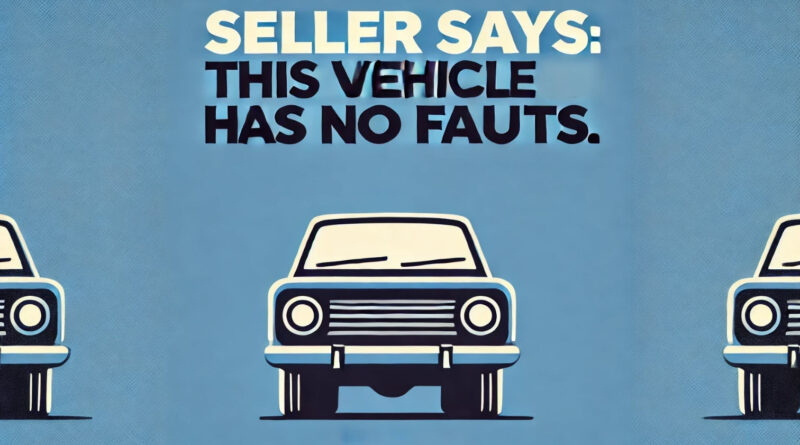“This Car Has No Faults!” Phrase Used Car Sellers Always Use
Let’s dig into why Car Has No Faults this phrase is so common, the tricks sellers use to back it up, and how you can spot the truth before it’s too late. If you’ve ever shopped for a used car, you’ve probably heard a seller say, “This car has no faults!” It’s the ultimate reassurance—but is it really true? Often, it’s not. While there are honest sellers out there, some use this claim to gloss over issues that could cost you big once you drive away.
Why Do Sellers Claim “No Faults”?
Saying a car has no faults is an easy way to grab a buyer’s attention. Most used cars never have properly carried out inspections. It builds trust, makes the vehicle seem like a great deal, and can even justify a higher price. Unfortunately, cars—especially used ones—rarely come without some wear and tear or underlying issues. The truth? A lot of sellers rely on this statement to speed up a sale without full transparency.
Common Tricks Sellers Use to Hide Faults
Here are some ways dishonest sellers back up their “no faults” claim while keeping the real issues out of sight:
1. Covering Up Mechanical Problems
Some sellers go to great lengths to hide engine or transmission issues. They might temporarily clear warning lights or use thicker oil to mask noises.
- What They Say: “The engine runs perfectly!”
- What’s Really Happening: The check engine light might pop back on a week after you buy it.
2. Disguising Cosmetic Damage
Sellers often downplay scratches, dents, or even signs of major accidents. A quick respray or a buff job can make a damaged car look spotless.
- What They Say: “It just had a little touch-up work—nothing serious.”
- What’s Really Happening: That “little touch-up” might be hiding previous accident damage or rust.
3. Masking Suspension or Steering Issues
Suspension and steering problems can be dangerous, but some sellers hope you won’t notice them during a short test drive.
- What They Say: “It handles great!”
- What’s Really Happening: Worn suspension parts might lead to uneven driving or wobbling at higher speeds.
4. Faking Service Records
A car with a full service history is a great find—but what if the records aren’t real? Some sellers fabricate or cherry-pick maintenance details to make the car seem well cared for.
- What They Say: “It’s been fully serviced and is in top shape.”
- What’s Really Happening: The timing belt might never have been replaced, putting you at risk of costly repairs.
5. Downplaying Warning Signs
Dashboard lights, odd noises, or smoke from the exhaust can all signal trouble. Sellers might dismiss these as minor quirks to avoid scaring you off. Clearing faults before customers arrival.
- What They Say: “That light just came on—it’s probably nothing.”
- What’s Really Happening: That “nothing” could be a costly emissions issue or a failing sensor.
How to Spot the Lies
Don’t let a polished sales pitch fool you. Here’s how to dig deeper and find out if “no faults” is really true:
1. Inspect the Car Thoroughly
Look closely for hidden damage. Check for mismatched paint, uneven panel gaps, or rust in less obvious spots like under the car or in the trunk.
2. Test Drive Like a Pro
Take the car on a proper test drive—not just a quick loop. Drive at different speeds, listen for unusual noises, and pay attention to how the car feels.
3. Get a Vehicle History Report
Use tools like Carfax or AutoCheck to check the car’s accident history, mileage, and ownership details. If the seller is hiding something, it’ll likely show up here.
4. Bring in a Mechanic
A pre-purchase inspection by a trusted mechanic is one of the best ways to uncover hidden issues but make sure mechanic all the tool with him and vehicle is raised and road tested. A professional can spot problems that aren’t obvious to the untrained eye if the careful inspection is carried out.
5. Ask the Right Questions
Ask specific questions like:
- Has the car been in any accidents?
- What repairs or maintenance have been done recently?
- Are there any warning lights or pending issues?
Vague answers or hesitation could be a red flag.
What to Do If You Find Faults After Buying
Sometimes, faults don’t show up until after you’ve bought the car. Here’s how to handle it:
- Check the Sale Agreement: Did the seller offer any guarantees or warranties?
- Contact the Seller: Try to resolve the issue directly. Honest sellers may work with you to fix the problem.
- Know Your Rights: Depending on your location, you may be protected by consumer laws. For example, in the UK, the Consumer Rights Act gives buyers recourse if the car wasn’t as described.
What Honest Sellers Do Differently
Not all used car sellers are out to trick you. A trustworthy seller will:
- Be upfront about any known faults or issues.
- Provide detailed service records and documentation.
- Offer a chance to inspect the car thoroughly before purchase.
When sellers are transparent, it’s a good sign they’re confident in the car’s overall condition.
Final Thoughts
The claim “This car has no faults” is often too good to be true. While some sellers genuinely mean it, others use it as a way to brush over problems that could cost you money and headaches down the road.
The best way to protect yourself is to stay informed, do your research, and never rush into a purchase. By asking the right questions and taking the time to inspect the car, you’ll be better equipped to separate the good deals from the bad—and avoid the pitfalls of a “no faults” lie.
Buying a used VW. Buying used vauxhall, BMW, Jaguar, Ford, Volvo, Range rover, Bentley, Aston Martin, Porsche, Ferrari, Lamborghini, Maserati, Hyundai, Tesla, Honda, Pagani

